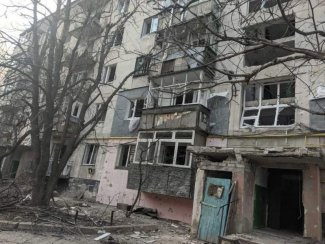Russia’s attack on Ukraine: day 48

According to the Ukrainian account, in the forty-eighth day of the war the military situation has not changed fundamentally. On the Slobozhansky direction the partial blockade and shelling of Kharkiv continued (the defenders were to succeed on the northern – Derhachi – and eastern – Rohan – directions of the city’s defence). Barvinkove, 35 km southwest of Izium, also came under enemy fire (an additional subdivision of the 1st Tank Army of the Western Military District was to be sent to the combat area). In the temporarily occupied part of the Kharkiv Oblast the Russians were also to begin forming subdivisions of the so-called people’s militia from the local population.
In the Donetsk direction, the defenders were to repel six hostile attacks. The main areas of fighting in the Luhansk Oblast remain the areas along the lines of Popasna–Zolote–Nyzhnie and Kreminna–Rubizhne–Novodruzhesk (south and north of the shelled Lysychansk and Sievierodonetsk, respectively), and in the Donetsk Oblast the towns of Avdiyivka, Ocherytne, Marinka, Stepne and Vuhledar (north and west of Donetsk) and Mariupol (fighting for the port and the Azovstal combine is still to continue, although there are also many reports of the critical situation of the city’s defenders). In order to improve logistics, the enemy is repairing a railway bridge in the area of the town of Svatove in Luhansk Oblast, 50 km north of Sievierodonetsk.
In the Taurida direction, Russian forces intensified their shelling of Ukrainian positions south of Zaporizhzhia (phosphorus shells were to fall on the village of Novodanylivka south of the town of Orikhiv, in the centre of the defence line). In the Southern Buh river direction, fighting continued for another day on the border of Kherson Oblast with Dnipropetrovsk and Mykolaiv oblasts (Mykolaiv and Oleksandrivka were shelled). As a result of the rocket strikes, infrastructure in Myrhorod, Poltava Oblast, and the railway line between Shepetivka and Berdychiv (probably south of Chudniv), which was blocked for over seven hours, suffered damage.
The General Staff of the Armed Forces draws attention to the intensified informational and administrative-police protection of regrouping and movement of subdivisions of the Russian army to the regions of concentration in the regions bordering Ukraine (under the so-called yellow terrorist threat level). The aggressor is to complete the movement to the Belgorod and Voronezh oblasts of sub-units of the 41st Combined Arms Army (CAA) and the 90th Tank Division from the Central Military District (MD). To reinforce the grouping, it was also to accelerate the training in the Eastern MD and the rallying of Rosgvardia subdivisions. As part of directing so-called volunteers to participate in the operation, a 400-strong battalion consisting of soldiers with combat experience was to be formed in the Leningrad Oblast. It is to supply one of the subdivisions of the 42nd Mechanised Division from the 58th CAA of the Southern MD. According to the Ukrainian side, the Russian command is to review the terms of the contracts to prevent soldiers from terminating them in case of involvement in hostilities outside the country.
The Ukrainian General Staff emphasises the persistence of the threat posed by the remaining Russian Army grouping on Ukraine’s north-eastern borders (on the Siversky direction), which is expected to tie down the defenders’ forces and thus prevent their use in other directions. It also draws attention to the persistently increased activity of the Belarusian Armed Forces.
On 13 April, the Office of the President reported that several hundred soldiers of the 36th Separate Naval Infantry Brigade named after Rear Admiral Belyinsky had managed to get out of the centre of Mariupol and reunite with the Azov regiment defending itself in the Azovstal combine. The operation was preceded by a dramatic appeal by the soldiers to the authorities for help due to a shortage of ammunition and provisions.
On 12 April, 2,600 people were evacuated from the areas of Zaporizhzhia (towns of Polohy, Vasilivka, Berdiansk, Melitopol), Luhansk (Lysychansk, Sievierodonetsk, Rubizhne, Kreminna, Popasna) and Donetsk (Mariupol) oblasts. Evacuation from Berdiansk, Tokmak and Enerhodar has been blocked by the Russians. No humanitarian corridor will operate on 13 April. In Zaporizhzhia Oblast, the occupiers were said to have blocked evacuation buses, and in Luhansk Oblast, temporary cease-fire arrangements are being violated. Ukrainian Railways is today running evacuation services on the routes: Pokrovsk–Chop, from Lviv to Zhmerynka and Poltava, from Sloviansk to Lviv, from Kharkiv to Ivano-Frankivsk, from Novozolotarivka to Lozova and from Chop to the Dnipro.
The head of the Luhansk military administration appealed to residents to leave the Oblast immediately due to the increasingly difficult humanitarian situation and the threat of terror from Russian soldiers. The head of Kyiv’s military administration, Oleksandr Pavluk, called on people to refrain from returning home at least until the end of May, as a significant number of towns in the Oblast are mined and work is still underway to restore electricity and gas supplies. In turn, the chief of staff of the local military administration Serhiy Korniychuk reminded that there is still a threat of a direct attack on the capital.
Vladimir Putin has referred to accusations that Russian soldiers committed war crimes in Bucha – describing them as ‘fakes’ similar to allegations of chemical weapons use during the war in Syria. In his opinion, the ‘staged events in Bucha’ served as a pretext for Kyiv to break off peace talks despite the ‘creation of appropriate conditions’ by the Russian side. In turn, an adviser to the Ukrainian president and a participant in the negotiations Mykhailo Podolak said that the negotiations are ongoing and are taking place in thematic subgroups online, although the Russians are trying to put media pressure on Ukraine to force it to accept unfavourable conditions for ending the conflict.
Presidents of Poland, Lithuania, Latvia and Estonia visited Kyiv on 13 April. On 12 April Volodymyr Zelensky spoke online before the Lithuanian parliament. He stressed that Vilnius had been a leader in supporting Ukraine from the beginning, and criticised insufficient Western sanctions. In a speech to the Estonian parliament on 13 April, he called for the EU to create instruments of pressure on Russia in order to stop the deportation of Ukrainians to that country. However, Ukrainian authorities rejected the offer to visit to Kyiv by German President Frank-Walter Steinmeier, who confirmed that the Ukrainian side deemed his visit undesirable. Ukraine’s ambassador to Berlin Andriy Melnyk suggested that Kyiv prefers Chancellor Olaf Scholz to visit Ukraine.
On 12 April, Viktor Medvedchuk, a key pro-Russian politician and one of the leaders of the suspended party Opposition Platform – For Life, was detained after his escape from house arrest following 24 February (he had been in house arrest since May 2021, charged with treason). He was captured in the Kiev region, while trying to get to the border in a military uniform - he was to be transferred to Transnistria, and from there, with the assistance of the Russian FSB, to Moscow. Zelensky said that Ukraine intends to exchange Medvedchuk for Ukrainian military men held in Russian captivity, and the deputy head of the Foreign Ministry said that a court trial should be conducted in his case earlier.
The message from the Ukrainian side is increasingly focusing on the crimes of the aggressor army against civilians. In his statements, President Zelensky refers to the atrocities and rapes committed by Russian soldiers against women and children. He also announced that law enforcement agencies are working to identify the personalities of all perpetrators. According to the police chief of the Kyiv Oblast, after the Oblast was recaptured by Ukrainian forces, 720 bodies of civilians killed have been discovered and identified; more than 200 are considered missing. In turn, the head of the Donetsk Regional State Administration reported that 20,000–22,000 people may have been killed in Mariupol since the beginning of the invasion. In turn, the Mer of Bucha reported the discovery of 403 bodies of civilian victims, many of which bear traces of torture. The bodies were found both in mass graves and individual burial sites in the city and on its outskirts. The number of those murdered is not final – the search is still going on for those missing and kidnapped by retreating Russian army soldiers.
Ukrainian ombudsman Lyudmyla Denysova reported that more than 700,000 civilians, including more than 130,000 children, have been deported to Russia from the Donetsk and Luhansk oblasts. According to her reports, there is a filtration camp in the Donetsk Oblast that houses 10,000 Ukrainians, and four camps in Russia’s Penza Oblast, to which residents of the occupied territories of the Donetsk and Luhansk oblasts were taken as recently as February this year, before the invasion began. Currently, around 20,000 people are taken to Russia every day; Ukrainians have been placed in 35 different Russian regions, around 100,000 were supposed to be taken to Siberia and beyond the Arctic Circle. The deportations were also confirmed by the Russian ombudsman, Tatyana Moskalkova.
Prime Minister Denys Shmyhal announced that the heating season was over, and 9 billion m3 of gas and 1 million tonnes of coal remain in storage. He also announced the start of the sowing campaign in all oblasts of Ukraine except Luhansk. The government decided to provide preferential loans to farmers in the amount of 3.5 billion hryvnias (about 110 million euros) and to simplify the procedure for registration of agricultural machinery.
According to data from the Polish Border Guard, since 24 February, 2.7 million people have entered Poland from Ukraine, and on 12 April almost 24,000 were checked in (0.2% less than the previous day).
Commentary
- For the last 24 hours, information from the combat areas continues to be limited. On 13 April, in the morning communiqué of the General Staff of the Ukrainian army, only Kharkiv and Mariupol are briefly mentioned, while activities in other localities are reported only by local sources. For the first time the evening communiqué by the Operational Command ‘East’ (on the Slobozhansky direction) was missing in the media coverage. For the second day in a row, the official message of the General Staff also failed to mention the aggressor’s problems with losses and logistical security, as well as morale and discipline. On the contrary, it mentioned successful volunteer recruitment in the Leningrad Oblast for the first time. This change can be interpreted as Ukrainian General Staff’s intention to emphasize the seriousness of the threat in connection with the expected great battle for the Donbas and eastern Ukraine. It also cannot be ruled out that it precedes possible information about the loss of important positions by the defenders.
- There are no announcements from the General Staff on the fighting in the Izyum area or from the Operational Command ‘East’ on the repulsion of subsequent attacks, while local reports inform about the aggressor’s shelling of the Barvinkove town (according to Ukrainian information, it was one of the targets of the Russian attack south of Izyum, the other being Sloviansk). This leads to an assumption that the invader achieved at least partial success. These events – unless the enemy troops are stopped in a new line of defence – can be seen as the beginning of the announced battle for eastern Ukraine, as so far most of the aggressor’s grouping remains in the areas bordering Ukraine. The Russians are making progress by reinforcing the units already engaged in the combat areas with single battalion tactical groups and increasing recruitment into the so-called separatist people’s militias.
- The Ukrainian authorities have made an open diplomatic démarche towards the German President by stating that his visit to Kyiv is not welcome. This is as much a signal to Berlin, whose support Ukraine considers far from sufficient, as to Steinmeier himself. For years, the Ukrainian side has criticised him for his lenient attitude towards Russia, his support of the construction of Nord Stream 2, and for the so-called Steinmeier formula – unfavourable but accepted by Kyiv in 2019 – which provided for special conditions for holding early local elections in the occupied areas of Donbas. Moreover, Ukraine is thus letting it be known that in its dialogue with Germany it prefers to deal with Chancellor Olaf Scholz – the key decision-maker and at the same time a politician who has declared a critical stance towards Moscow.





